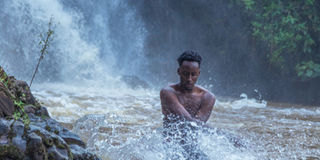Prime
A dip in the river, nature walks and native shrines welcome you to Sezibwa

One of the revellers swims in the Sezibwa river. Photos | BAsh Fahad Mutumba
What you need to know:
- Getaway. You do not have to break the bank to travel to a dream destination. Sezibwa is one of top places you engage in adventure, writes Bash Fahad Mutumba.
About 30 kilometres from Kampala before Lugazi Town, a dirt road leads us to a gate. Before we alighted from the car, I could already feel the cool breeze on my skin. Then, we approached through the pathway adorned by tall reeds and trees.
The multitude of bird species, including the ashy flycatcher, the African finfoot and the paradise flycatcher that Sezibwa is famous for chirp in unison. As we checked in, the adults were asked to pay Shs20,000 for those who intended to camp, and Shs5,000 for those who did not.
‘Sizibwa kkubo’
At the entrance, I could see the river from distance. I initially was repulsed by the brown tint in the water. A local then assured me that this happens once in a while since the river originates from a swampy area. and that I could swim if I wanted to. My colleagues on the other hand, did not even have to get this reassurance, as they undressed and dived in the river right after paying the entrance fee.
Standing on the famous timber bridge — partially covered by algae — I could see the Sezibwa River’s forceful descent from a cliff, and the subsequent calm of the rest of it as it passed under the bridge.
This is why our forefathers christened it Sezibwa, from the Luganda phrase “Sizibwa kkubo” which means ‘my path cannot be blocked’.
The creaks the bridge makes when one walks on it can be scary if you have hydrophobia. To the side were massive bamboo reeds and a steep hill which I climbed, towards the camping area and restaurant.
Waking up to oldness
As the sun set, I vowed to my friends that I would dive in the river the following morning, and I had to appreciate nature first.
At twilight, I woke to the coldness of Sezibwa that I had underestimated.
I jumped out of my small safari tent, ready to take in the niceness the river offered. I sipped on hot coffee as the sunrise painted the lush green of Sezibwa into a quiet gold. The river’s fall sounded particularly louder in the morning than the previous evening, perhaps because not many human voices were interrupting nature; apart from birds chirping in turns.
After the sun had fully come out, I set out to explore Sezibwa. I started with climbing the massive rocks west of the river, and found my way to the cliff where the falls begin their descent. Adults in the river looked almost like children. I continued with the nature walk, heading east of the river, through canopies of Muvule, Musizi, Mahogany, fig and eucalyptus trees. I could not enjoy the scenery because I was afraid of stumbling on the African cobra, green mamba and horned udder snakes that I had been earlier warned about. Not even the red-tailed monkeys and vervet jumps could calm my anxiety.
After I had escaped the canopies and landed in another set of massive rocks, my attention got caught by a group of men in cultural clothing enagaged in worship.
Light bulb moment!
I remembered the cultural story behind Sezibwa, and the belief among locals that the river was birthed by a woman as a twin. As I scrambled to take my leave, a man stopped me to tell me about the place.
“This is Nalongo’s shrine, and that is why you are hearing us sing songs of twins,” he stated, while puffing from his smoking his pipe.
“I am here to sing for Jajja Bamweyana (a deity responsible for providing to his worshipers, and is associated with intoxicants) even though many other gods are camped here,” he said.
He added that the cave was out of bounds to all women, and also to those men who had recently had sexual intercourse.
My curiosity died down, and I asked if there was a shorter route back to the campsite; to which he humbly responded with directions. After parting ways with the native religion practitioner, I needed a place to ease myself at the camping area.
A few feet away from the washrooms, I saw a natural dome of reeds that created a pathway for people to have therapeutic walks. I later discovered that this is called the ‘Walk of Lore’ by the people in charge of the tourist attraction. Ultimately, Sezibwa is that place everyone ought to visit.




